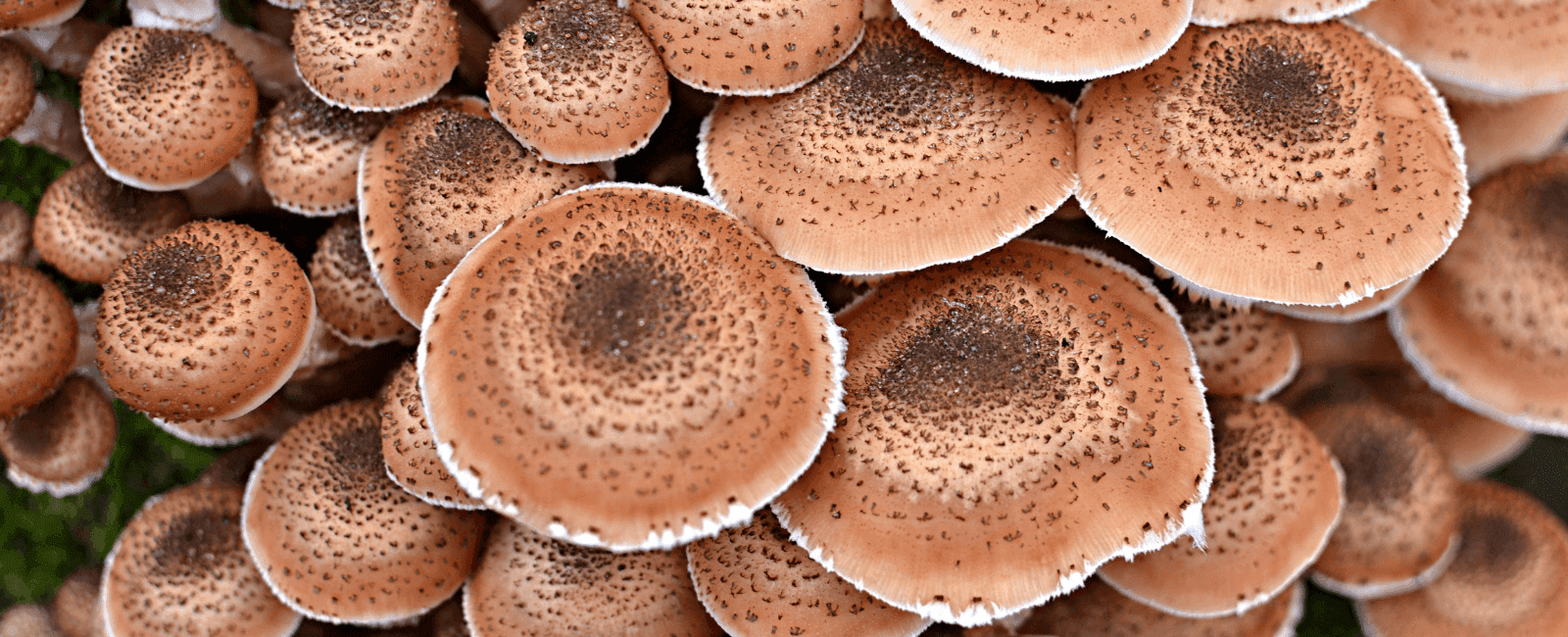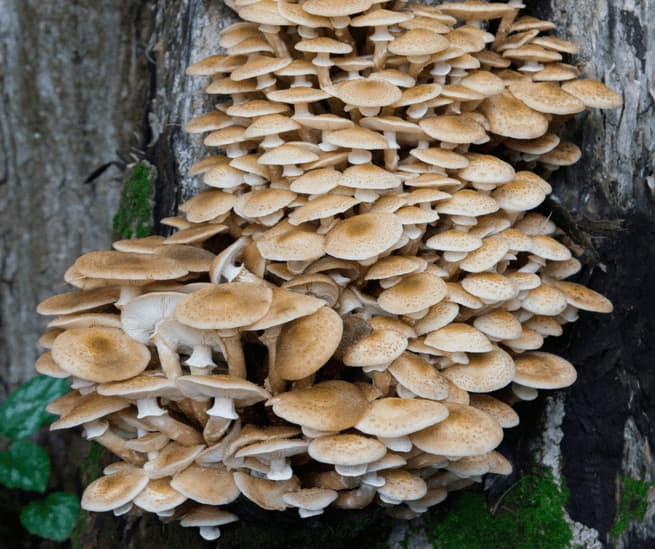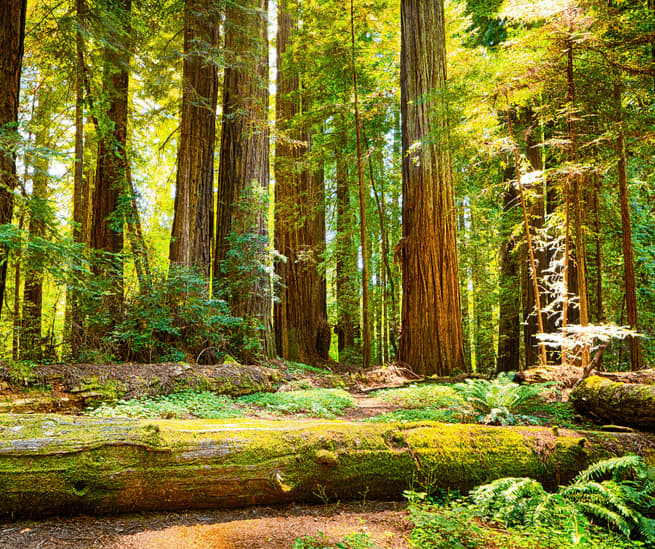

When you think about the largest single living organism on the planet, what comes to mind? Some may think — at least at first —that it’s a blue whale or a giant sequoia. But many people still don’t know about a little old thing called the “humongous fungus.”
Its total land mass covers an astounding distance and started growing millennia ago. This gigantic fungus comes from large stock: This mushroom’s closest cousin is bigger than three blue whales and can fit several Mall of America’s within its span.
Meet Armillaria ostoyae, the biggest being on the planet.
This fungus is the largest living organism on Earth

According to Scientific American, every fungus classified within the Armillaria genus is regarded as a honey mushroom. The fruiting bodies of honey fungus emerge as a white to yellow stem with a goldish brown cap. It may be covered in fibers or scales and has gills running underneath.
However, Armillaria ostoyae, colloquially known as the humongous fungus, is more than just the fruiting body. In fact, most of what makes the gigantic biomass that has earned it the reputation of “world’s largest known organism” is a root system of mycelia and hyphae.
The expansion of the fungus’s mycelium network crosses a range of 960+ hectares (nearly 4 square miles or 1,665 football fields, for the sports-inclined). Altogether, it would weigh around 400 tons.
A humongous habitat
Along its spread, thin filaments of hyphae grow up tree roots, secreting digestive enzymes that eventually bring down the native trees in the humongous fungus habitat of Malheur National Forest.
The mushroom is known to wrap tree roots in a girdle of mycelium that helps it essentially eat the decayed tree. Unlike many other types of mushrooms, A. ostoyae can move between its food sources — decaying trees don’t need to be connected for it to continue spreading.
This shroom isn’t only found in the Blue Mountains of Oregon. Armillaria ostoyae specimens have also been discovered growing in Michigan, making it clear that the fungus prefers conifer tree ecosystems.
With a rough estimation that places it to be anywhere from 2,400 to over 8,500 years old, many scientists agree that this fungus ranks as one of the oldest living organisms on the planet.
How does A. ostoyae grow?
The honey mushroom reproduces and survives through a special combination of abilities.
Fruiting body spores allow for the fungus to spread through typical sexual reproduction, while beneath the ground, it can also produce asexually through rhizomorphs. These specialized structures resemble flat roots and help the organism cross long distances without food sources.
This subterranean quality is what led to the discovery of the humongous fungus by scientists way back in 1998.
What unearthing Armillaria ostoyae means

The path to finding the world’s largest organism was as long as A. ostoyae’s territory. It started in 1992.
According to Scientific American, the first specimen of the fungus was found in Crystal Falls, Michigan, by a Ph.D. candidate from the University of Toronto, Myron Smith. According to Smith, his team was “looking at the boundaries of [fungal] individuals using genetic tests, and the first year we didn’t find the edge.”
Despite being a massive 100-ton, 1,500-year-old mushroom, that first fungus discovery wasn’t an A. ostoyae! Instead, it was classified as an Armillaria bulbosa, and later recognized as A. gallica.
That same year, a U.S. Forest Service scientist named Terry Shaw and forest pathologist Ken Russell found an exceptionally large sample of A. ostoyae in Washington state.
This discovery, covering a mere 2.5 square miles, was the first behemoth A. ostoyae to be recorded. It held its position as the biggest fungus in the forest until another relative honey mushroom unseated it in 2003.
But don’t feel bad about it. In all honesty, that’s like a millisecond in the lifespan of this organism. It probably didn’t even notice.
The current honey fungus queen was discovered by USFS scientist Catherine Parks, and tracks over 2,400+ acres. Yet, for such an outsized presence, A. ostoyae plays a moderate role in the local ecosystem.
Honey mushrooms in nature
As Armillaria ostoyae makes its slow march across its environment, it spreads an eponymous condition called Armillaria root disease to the woody roots of decaying trees.
As those trees die and decay, the humongous fungus helps them along the journey. It approaches its fallen form with an insatiable appetite, consuming and then recycling.
The spread of honey fungus hasn’t been an outstanding problem in most ecosystems for the past millennium and a half. Healthy natural cycles take all sorts, after all. Across its long life, A. ostoyae has served something of a clarifying role for the ecosystem, pruning ill-adjusted trees and returning their nutrients to the soil.
As climate change disrupts both micro and macro climates, the honey mushroom is finding its dinner plate ever more full.
A threat to the fungus? Not so much…

Human development, and the plague of climate change that follows us, have not been kind to flora and fauna of the Earth.
One needs to look only as far as the West Coast redwoods to see how true this is. Only 5% of the pre-Industrial Revolution redwood population remains. The intense wildfire fires of 2020, spurred by the continued desertification of California, were estimated to have killed 7,500 to 10,000 of them.
And redwoods are far from the only trees suffering. Other exceptional organisms, like the clonal colony of quaking aspen trees, known as Pando, are also dying.
Located in Utah, the 80,000-year-old aspen grove in Fishlake National Forest is under attack by grazing cattle and mule deer, which have exploded in population thanks to human culling of apex predators.
With that in mind, it’s highly reasonable to assume climate change is harming the life of A. ostoyae. In actuality, the opposite is true.
If you’ve been watching HBO’s The Last of Us, then your eyes might be open to the (albeit fictional) possibility of what it looks like when climate change actually assists the natural world in targeting humans.
Luckily honey mushrooms serve no direct threat to us. Instead, climate change and the fungi’s threat are actually much more mundane.
The Atlantic details how the Oregon honey mushroom’s current size is actually a symptom of human impact on the environment and its localized habitat.
Clear-cut logging and fire suppression, improved conditions for tree-deadly invasive insects, reduced plant variety — all of these weaken native trees and provide fresh fuel for the slow death march of the humongous fungus. Like humans, A. ostoyae prefers an easy meal.
The less resilient conifer trees become, the larger Armillaria ostoyae will grow. We won’t give you the second-grade science lesson on how important trees are to human life, but we can all agree that nature requires balance. And we need room for both fungi and forests.
The largest living thing is still growing

All in all, the humongous fungus is a complicated creature. It holds the lofty title of being the biggest organism by land area, which is a pretty cool claim to fame.
Yet for the fungus to continue holding that title, things have to be going pretty bad regarding the human impacts of climate change. With that in mind, most mycology fans can agree that it might be best if this fungus quits while it’s ahead.


